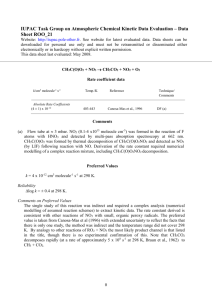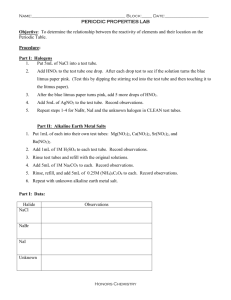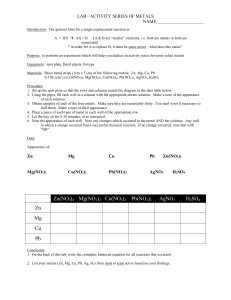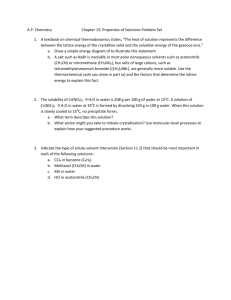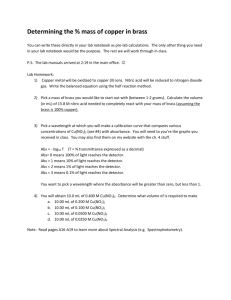Data Sheet VI.A1.04 HET_H2OL_4
advertisement
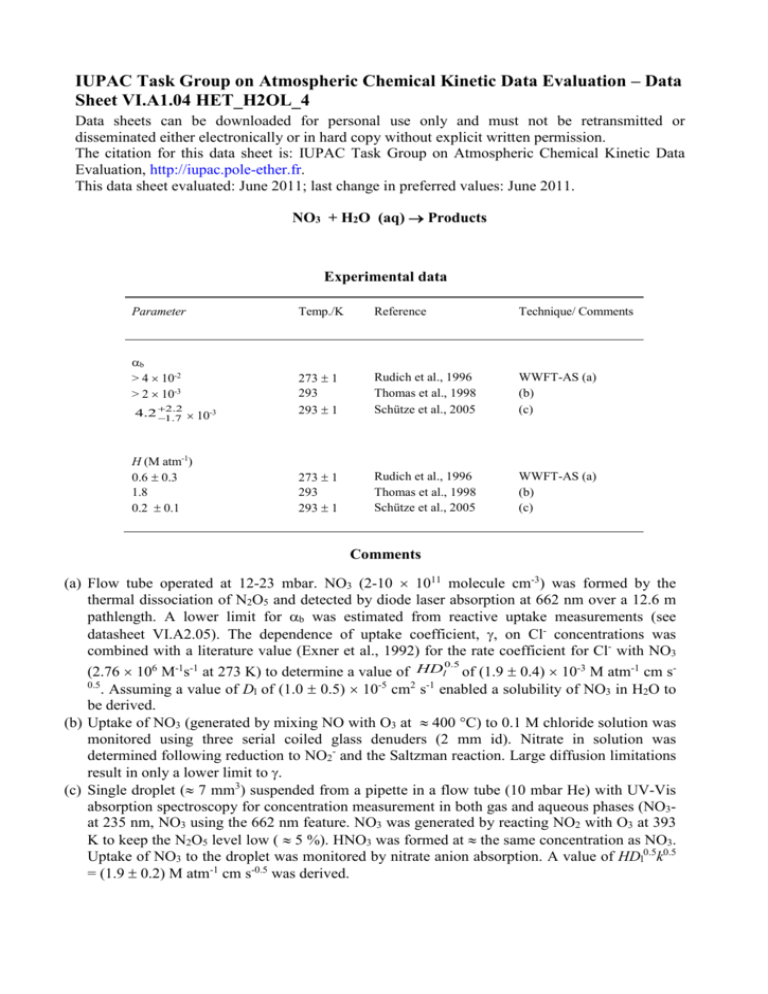
IUPAC Task Group on Atmospheric Chemical Kinetic Data Evaluation – Data Sheet VI.A1.04 HET_H2OL_4 Data sheets can be downloaded for personal use only and must not be retransmitted or disseminated either electronically or in hard copy without explicit written permission. The citation for this data sheet is: IUPAC Task Group on Atmospheric Chemical Kinetic Data Evaluation, http://iupac.pole-ether.fr. This data sheet evaluated: June 2011; last change in preferred values: June 2011. NO3 + H2O (aq) Products Experimental data Parameter b > 4 10-2 > 2 10-3 2.2 -3 4.2 1.7 10 H (M atm-1) 0.6 0.3 1.8 0.2 0.1 Temp./K Reference Technique/ Comments 273 1 293 293 1 Rudich et al., 1996 Thomas et al., 1998 Schütze et al., 2005 WWFT-AS (a) (b) (c) 273 1 293 293 1 Rudich et al., 1996 Thomas et al., 1998 Schütze et al., 2005 WWFT-AS (a) (b) (c) Comments (a) Flow tube operated at 12-23 mbar. NO3 (2-10 1011 molecule cm-3) was formed by the thermal dissociation of N2O5 and detected by diode laser absorption at 662 nm over a 12.6 m pathlength. A lower limit for b was estimated from reactive uptake measurements (see datasheet VI.A2.05). The dependence of uptake coefficient, , on Cl- concentrations was combined with a literature value (Exner et al., 1992) for the rate coefficient for Cl- with NO3 0.5 (2.76 106 M-1s-1 at 273 K) to determine a value of HDl of (1.9 0.4) 10-3 M atm-1 cm s0.5 . Assuming a value of Dl of (1.0 0.5) 10-5 cm2 s-1 enabled a solubility of NO3 in H2O to be derived. (b) Uptake of NO3 (generated by mixing NO with O3 at 400 C) to 0.1 M chloride solution was monitored using three serial coiled glass denuders (2 mm id). Nitrate in solution was determined following reduction to NO2- and the Saltzman reaction. Large diffusion limitations result in only a lower limit to . (c) Single droplet ( 7 mm3) suspended from a pipette in a flow tube (10 mbar He) with UV-Vis absorption spectroscopy for concentration measurement in both gas and aqueous phases (NO3at 235 nm, NO3 using the 662 nm feature. NO3 was generated by reacting NO2 with O3 at 393 K to keep the N2O5 level low ( 5 %). HNO3 was formed at the same concentration as NO3. Uptake of NO3 to the droplet was monitored by nitrate anion absorption. A value of HDl0.5k0.5 = (1.9 0.2) M atm-1 cm s-0.5 was derived. Preferred Values Parameter kH2O (M-1 s-1) H (M atm-1) Value 1.3 10-2 23 0.6 T/K 273 273 273 log (b) log (kH2O) log (H) 0.5 0.5 0.5 273 273 273 b Reliability Comments on Preferred Values The accommodation coefficient, b, was derived from uptake of NO3 to salt solutions as described in datasheet VI.A2.05. The solubility, H, of NO3 has been determined on several occasions, the more recent results suggest that it is low, with numbers of (0.6 0.3) and (1.8 1.5) M-1 atm-1 derived by Rudich et al (1996b) and Thomas et al (2005) compared to e.g. 12 M-1 atm-1 reported by Chameides (1986). We prefer the results of Rudich et al., in order to maintain an internally consistent set of parameters for modelling NO3 uptake to both pure water and halide solutions (see VI.A2.05). Rudich et al. (1996) observed reactive uptake of NO3 in the absence of halide ions (or other detectable impurities) and attributed this to the hydrolysis of NO3 : NO3(aq) + H2O OH(aq) + HNO3(aq) Rforward OH(aq) + HNO3 NO3(aq) + H2O Rback 30 -1 -1 with a rate constant of kH2O = 23 13 M s for the forward reaction. Similarly, Schütze et al. (2005) observed reactive uptake and formation of nitrate ions in the interaction of NO3 with a pure H2O droplet with an uptake coefficient of ~10-4 implying a hydrolysis rate coefficient of 2300 -1 -1 670 580 M s if nitrate (i.e. aqueous phase HNO3) was formed only as shown above. Even the lower limits of these rate constants are incompatible (by orders of magnitude) with the observations of Thomas et al (1998), who derive an upper limit of 0.5 M-1 s-1 for kH2O. Whilst Rudich et al., made efforts to eliminate reaction with impurities in their water film and ruled out gas-phase reactions as being responsible for NO3 loss, Thomas et al. hypothesise that impurities, a surface (rather than bulk) reaction of NO3 or non-laminar flow in the liquid film of Rudich et al could contribute to observation of an apparent, large hydrolysis rate constant. On the other hand, calculations of the equilibrium constant for reaction of NO3 with water Rudich et al (1996b) combined with the measured rate constant for the back reaction (Katsamura et al., 1991) result in kH2O = 6 M-1 s-1 at 298 K, roughly consistent with the observations. Whilst recognising that there is very large uncertainty associated with values of each of b, H and kH2O, we adopt the results of Rudich et al. (1996) so that the following expression, when used to calculate an uptake coefficient for NO3 on pure water, returns a value of ~ 210-4, which is consistent with their experimental observations. 1 1 c 0 . 5 4 HRT ( D k ' ) b lH 2 O with Dl ~ 1 10-5 cm2 s-1. The aqueous phase products of NO3 hydrolysis are suggested to be OH and HNO3. Clearly, further work on the uptake and reaction of NO3 on water is required to reduce uncertainties associated with this process. References Chameides, W. L., J. Geophys. Res. 91, 14571-14572, 1986. Exner, M., Herrmann, H. and Zellner, R.: Ber. Bunsen. Ges. Phys. Chem. Chem. Phys 96, 470477, 1992. Rudich, Y., Talukdar, R. K., Ravishankara, A. R. and Fox, R. W.: J. Geophys. Res. 101, 21023-21031, 1996. Schütze, M. and Herrmann, H.: J. Atmos. Chem. 52, 1-18, 2005. Thomas, K., Volz-Thomas, A., Mihelcic, D., Smit, H. G. J. and Kley, D.: J. Atmos. Chem. 29, 17-43, 1998.



